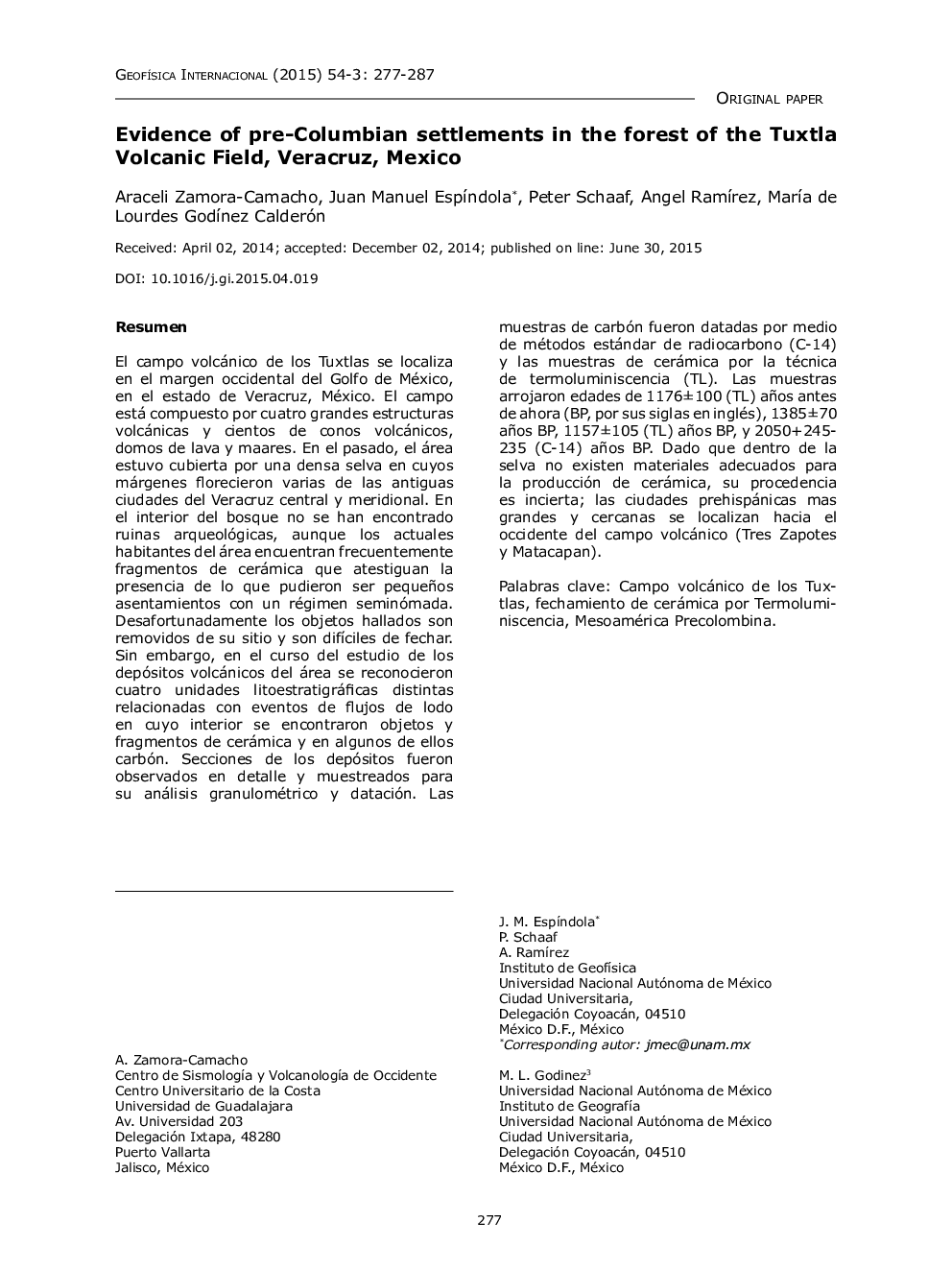| کد مقاله | کد نشریه | سال انتشار | مقاله انگلیسی | نسخه تمام متن |
|---|---|---|---|---|
| 4674320 | 1634290 | 2015 | 11 صفحه PDF | دانلود رایگان |

ResumenEl campo volcánico de los Tuxtlas se localiza en el margen occidental del Golfo de México, en el estado de Veracruz, México. El campo está compuesto por cuatro grandes estructuras volcánicas y cientos de conos volcánicos, domos de lava y maares. En el pasado, el área estuvo cubierta por una densa selva en cuyos márgenes florecieron varias de las antiguas ciudades del Veracruz central y meridional. En el interior del bosque no se han encontrado ruinas arqueológicas, aunque los actuales habitantes del área encuentran frecuentemente fragmentos de cerámica que atestiguan la presencia de lo que pudieron ser pequeños asentamientos con un régimen seminómada. Desafortunadamente los objetos hallados son removidos de su sitio y son difíciles de fechar. Sin embargo, en el curso del estudio de los depósitos volcánicos del área se reconocieron cuatro unidades litoestratigráficas distintas relacionadas con eventos de flujos de lodo en cuyo interior se encontraron objetos y fragmentos de cerámica y en algunos de ellos carbón. Secciones de los depósitos fueron observados en detalle y muestreados para su análisis granulométrico y datación. Las muestras de carbón fueron datadas por medio de métodos estándar de radiocarbono (C-14) y las muestras de cerámica por la técnica de termoluminiscencia (TL). Las muestras arrojaron edades de 1176±100 (TL) años antes de ahora (BP, por sus siglas en inglés), 1385±70 años BP, 1157±105 (TL) años BP, y 2050+245-235 (C-14) años BP. Dado que dentro de la selva no existen materiales adecuados para la producción de cerámica, su procedencia es incierta; las ciudades prehispánicas mas grandes y cercanas se localizan hacia el occidente del campo volcánico (Tres Zapotes y Matacapan).
The basaltic Los Tuxtlas Volcanic Field (LTVF) is located at the western margin of the Gulf of Mexico in the State of Veracruz, Mexico. The field is a massif composed of four large volcanic structures and hundreds of scoria cones, lava domes and maars. This area was in the past covered by a dense forest in whose margins flourished several of the ancient cities of importance in central and southern Veracruz. Within the forest no enduring archeological ruins have been found; but the present inhabitants of the area frequently find fragments of ceramics and stone that attest to the presence of what could have been small settlements with a seminomadic regime. Unfortunately the objects found have been removed from their emplacement and are difficult to date. However in the course of our study of the volcanic deposits in the area we found four mudflow deposits containing pre- Columbian pottery objects and shards, as well as charcoal in some of them. Sections of the deposits were observed in detail and sampled for granulometric analysis. The charcoal samples were dated using standard radiocarbon methods (C-14); where charcoal was absent the pottery shards were dated with thermoluminescence (TL) techniques. The samples from these sites yielded ages of 1176±100 years BP (TL), 1385±70 BP years (C-14), 1157±105 years BP (TL), and 2050+245-235 years BP (C-14). Since in the area there is no clayey and silty material suitable for production of pottery; the closest and largest prehispanic cities, Tres Zapotes or Matacapa, are located to the west of the LTVF.
Journal: Geofísica Internacional - Volume 54, Issue 3, July–September 2015, Pages 277–287